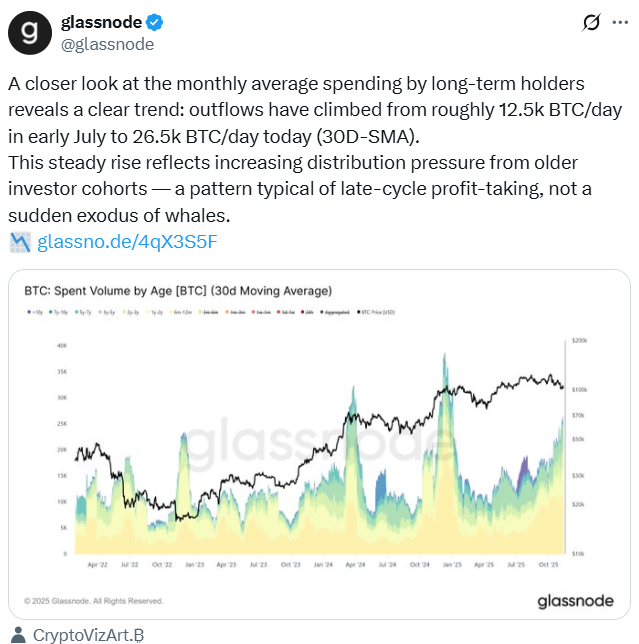Bitcoin’s recent wave of whale selling pressure is typical of a late-stage crypto cycle and should be no more concerning than it has been in the past, according to analysts from Glassnode.
On Thursday, a major Bitcoin whale, identified as trader Owen Gunden, made moves toward selling, transferring 2,400 Bitcoin (BTC), worth $237 million, to the crypto exchange Kraken, according to blockchain analytics platform Arkham.
It adds to a recent spate of Bitcoin whales seemingly shifting away from the cryptocurrency.
Glassnode analysts, however, argued that the data show that narratives such as “OG Whales Dumping” or “Bitcoin’s Silent IPO” are more nuanced in reality.
Monthly average spending by long-term holders indicates inflows have climbed from over 12,000 Bitcoin per day in early July to around 26,000 as of Thursday, Glassnode said, which points to regularly and evenly spaced distribution, not “specifically OG dumping, but normal bull-market behavior.”
“This steady rise reflects increasing distribution pressure from older investor cohorts — a pattern typical of late-cycle profit-taking, not a sudden exodus of whales.”

“Long-term holders have been realizing profits throughout this cycle, just as they did in every previous one,” Glassnode added.
Crypto market hasn’t topped yet: Kronos Research
Speaking to Cointelegraph, Vincent Liu, the chief investment officer at quantitative trading firm Kronos Research, said that whale sales are a structured cycle flow, and steady profit rotation, rather than panic, often indicate a late-cycle phase, along with rising realized gains and resilient liquidity.
Liu, however, said this “late-cycle” phase doesn’t necessarily mean the market has topped, as long as there are buyers to scoop up the new supply.
“Late cycle doesn’t mean the market is capped, it means momentum has cooled while macro and liquidity steer the ship. Fading rate-cut bets and short-term softness have slowed upside, not sunk it,” Liu said.
“On-chain readings hint at a potential bottom. Bitcoin’s net unrealized profit ratio at 0.476 signals short-term lows may be forming, offering strategic positioning but it’s just one of many indicators that need to be tracked to confirm a market bottom.”
Crypto market sentiment has been fearful as the broader market continues to slump. Analysts have attributed this to a range of macroeconomic factors, such as traders shifting to assets with clearer exposure to economic policies and credit flows.
Market tops are usually four years apart
Charlie Sherry, the head of finance at Australian crypto exchange BTC Markets, said whales selling in isolation isn’t usually significant, but this time, there is a noticeable lack of meaningful support on the buy side to absorb that selling.
However, he still thinks it’s too early to know if this is a sign of a cycle peak, though it is plausible.
Market tops have historically occurred roughly four years apart, as seen in December 2017, around 1,067 days after the bottom, and then in November 2021, approximately 1,058 days after the low.







